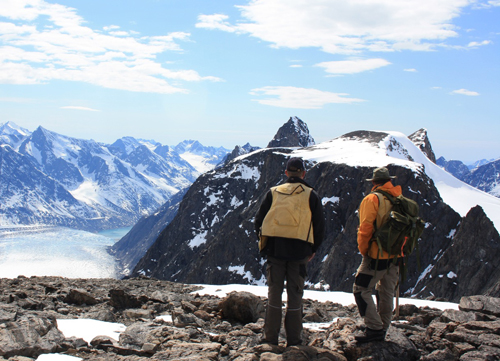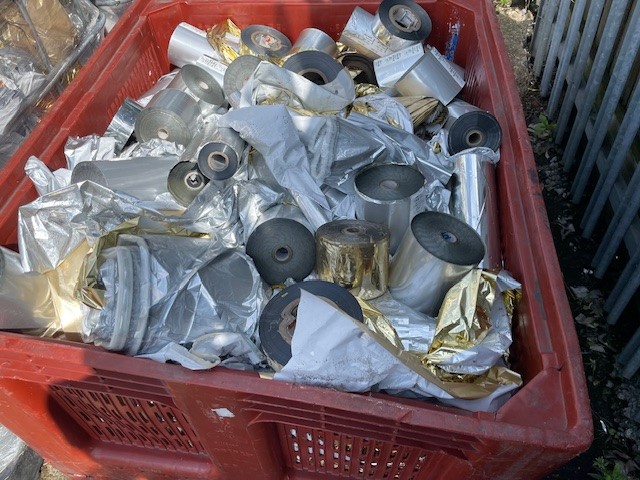
NunaMinerals is at the forefront of gold exploration in Greenland – and it is a company with a proven record of success. Its CEO, Greenlandic geologist Ole Christiansen was responsible for the discovery and initial development of what remain today the country's only producing mine, the Nalunaq Goldmine in South Greenland, as well as the Seqi olivine mine near Maniitsoq in West Greenland, currently on ‘care and maintenance’. NunaMinerals is currently working hard to develop the next generation of gold mining prospects. “Our primary focus and internal expertise has always been and will continue to be gold,” says NunaMinerals’ Chief Geologist, Joshua Hughes.
In fact almost all his and the company's efforts are currently going into fast tracking the company's Vagar gold discovery, which he says, represents the most significant discovery ever made by NunaMinerals since its inception in 1998. Vagar is located only 25 kilometres from existing mining infrastructure at Nalunaq, and only eight kilometres from an ice-free deep water fjord allowing year round access.
Vagar is an early stage project, which was tested by a limited drilling program at the Amphibolite Ridge target, for the first time in the summer of 2012. Despite the limited campaign, the results were enough to convince Hughes and Christiansen that the project has significant commercial potential (for example 57.4 metres with 1.33 grammes per tonne (g/t) gold in the ‘discovery hole’). So this summer will see further drilling as NunaMinerals moves towards its next major goal, a listing on the Toronto Stock Exchange (TSX), using Vagar as its 'qualifying project'.
The company is currently listed on the NASDAQ OMX Copenhagen Stock Exchange, with the Greenland Home Rule Government representing the single largest shareholder, controlling just over 33 percent of the shares. A listing in both Denmark and Canada would give the company exposure to a whole new source of capital. “We are pursuing a listing on the TSX to expose us to a wider base of investors who are more experienced with the mineral exploration industry, as we begin to progress Vagar through to resource definition over the next few years,” says Hughes.
As a company focused on gold NunaMinerals believes it is sitting on a previously unsuspected asset where Vagar is concerned. The gold mineralisation at Vagar displays numerable geological similarities with the highly productive gold deposits of the Tintina Gold Province of Alaska and the Yukon. The company firmly believes Vagar has the potential to host bulk mineable gold deposits of significant proportions. “It is not a single deposit but a whole belt of gold mineralisation stretching over 150 kilometres – the Nanortalik Goldbelt,” explains Hughes. “What is significant is that earlier explorers in South Greenland had never realised the potential for intrusive igneous rocks to contain gold – their focus has always been limited, targeting gold bearing quartz veins hosted within non-granitic, prominently mafic, packages. The fact we are now finding gold conforming to Intrusion Related Gold Systems (IRGS), a deposit type that has never been previously tested in the region, opens up huge areas of southern Greenland for gold exploration. In addition to the high-grade quartz veins (up to 1,013 g/t gold at the ‘Amphibolite Ridge’ target), the granitic host rocks themselves are also gold mineralised, offering significant tonnage potential. This marks a paradigm shift in Greenlandic gold exploration and our new approach is already yielding results. As a company we have a first mover advantage, with some of the best licences for gold, covering nearly all of the known gold occurrences in southern Greenland.”
So while Vagar is expected to be NunaMinerals' project of potentially ‘company making' proportions, it has a further very promising gold property at their Storø project within the Archaean Nuuk Fjord Greenstone Belt, conveniently located only 40 kilometres from the capital. Over 15,000 metres of drilling has already been competed at Storø to date. Of the approximately 7,500 square kilometres of exclusive exploration licences NunaMinerals holds at present, nearly 6,500 are primarily prospective for gold.
NunaMinerals' strategy is to concentrate on its core gold activities while still participating in other mineral projects by means of joint ventures. “Previously we have had partnerships with majors including Rio Tinto and Implats. We recently signed a Memorandum of Understanding with Korea Resources Corporation (KORES), a state owned exploration company, and are currently in active discussions with a number of other international parties, which we are confident will lead to the creation of joint venture partnerships on several of our projects within a one to two year window,” states Hughes.
In addition to its gold assets NunaMinerals possesses a varied exploration portfolio incorporating base and specialist metals, as well as diamonds. One such project is a high-grade rare earth elements (REE) deposit, with associated tantalum and niobium credits, at the Qeqertaasaq carbonatite complex of West Greenland. The simple carbonate mineralogy of the ore from Qeqertaasaq makes it amenable to low cost acid leaching, requiring no pre-concentration or grinding, entirely eliminating a substantial proportion of the projected processing costs. NunaMinerals is actively working alongside the US based company, ‘IntelliMet’ to develop a metallurgical flow sheet for the ore using their revolutionary selective solid phase extraction technology.
The second is at Ymer Ø in East Greenland which hosts high concentrations of antimony, tungsten and gold. “Ymer Ø has been subject to limited drilling historically, which was successful in revealing exceptionally high-grade tungsten (for example 14.07 percent over seven metres) and antimony (up to 20.89 percent over two metres) mineralisation. We now have several robust, drill-ready targets identified from a recent airborne geophysical survey, which are supported by geochemistry,” says Hughes.
Then at Inglefield Land, a vast terrain in the high arctic of northwest Greenland, NunaMinerals holds an extensive licence covering more than 5,000 square kilometres. Recently GEUS, the Geological Survey of Denmark and Greenland, has proclaimed Inglefield Land as one of the most promising areas in the whole of Greenland for finding new zinc deposits, based upon stream sediment anomalies. Significantly NunaMinerals' licence contains a cluster of the highest stream sediment zinc anomalies in the whole of northern Greenland, which is already known to host major zinc deposits such as Ironbark Zinc's advanced project at Citronen Fjord. “We are conducting grass roots exploration across Inglefield Land, targeting a number of commodities, including copper-gold, nickel-cobalt-gold, and zinc,” explains Hughes. “Despite the very early stage that the project is at, the area has already yielded ore-grade samples of both copper-gold and nickel-cobalt-gold mineralisation.”
As an indigenous company, NunaMinerals is deeply rooted and well respected within the national and local community. The company is also keen to promote Greenlandic technical staff. “I am very proud of our team. The majority are Greenlandic and are experts in Arctic logistics, which is essential when exploring in the most northerly country in the world. Mineral exploration is a continuous balance between risk and geological prospectivity – we are able to significantly reduce those risks through truly understanding the environments in which we operate and the logistical challenges we need to overcome to reach our goals,” concludes Hughes.
Written by John O’Hanlon, research by Richard Halfhide
DOWNLOAD
 NunaMinerals-Greenland-SPR-Bro-s.pdf
NunaMinerals-Greenland-SPR-Bro-s.pdf












